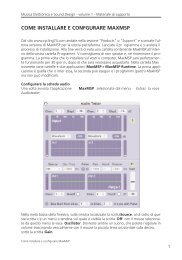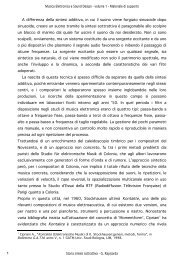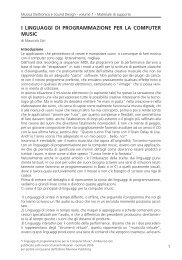programming with max/msp - Virtual Sound
programming with max/msp - Virtual Sound
programming with max/msp - Virtual Sound
Create successful ePaper yourself
Turn your PDF publications into a flip-book with our unique Google optimized e-Paper software.
1.1<br />
56<br />
Practice<br />
Paragraph 1.1 - First steps <strong>with</strong> Max/MSP<br />
Watch out! The gain~ object has two outlets, which are again poorly distinguished<br />
from each other. Because of this, you should verify that you’ve used<br />
the left outlet for making both connections. The best way to ascertain that<br />
you’ve used the correct outlet is to read the object assistance text that appears<br />
when you make the connection, and to make sure that it contains the text<br />
“gain~: (signal) Scaled Output”. If one of the two cables were to be solid<br />
black rather than yellow-and-black striped as they appear in the figure above,<br />
this would indicate the you’ve mistakenly used the right outlet, in which case<br />
you would need to cancel the patch cord by selecting the cord <strong>with</strong> a click<br />
(causing it to appear fatter) and pressing the key (which is the same<br />
key that you press to delete text). The cord would disappear, and you could<br />
then reconnect the objects, using the correct inlet/outlet pair.<br />
Now would be a good time to save your new patch to disk, keeping this warning<br />
in mind: DON’T EVER save your patches to a file that shares a name <strong>with</strong><br />
a pre-existing Max/MSP object! For example, don’t call this patch cycle~ (or<br />
cycle <strong>with</strong>out the tilde, for that matter!) Doing this would be a recipe for confusing<br />
Max, and for causing unexpected results the first time that you tried to<br />
reload your patch. Given that it is impossible to remember all of the names for<br />
Max/MSP objects, a good technique for avoiding the use of object names, and<br />
therefore averting the danger of a confusing name, is to give your files a name<br />
composed of more than one word: “test oscillator”, for example, or “cycle~<br />
object test”, or any other combination. No Max object possesses a name composed<br />
of more than one word.<br />
Don’t forget this advice! A large percentage of the problems encountered by<br />
Max beginners are related to saving files that share a name <strong>with</strong> some internal<br />
object. We will return to this topic and explain the logic behind it in the interlude<br />
that follows this chapter.<br />
Good! We’ve finished implementing our first patch, and we are ready to make it<br />
run. It lacks one more touch, however: up till now we’ve been in edit mode, in<br />
which we assemble patches by inserting, moving and connecting objects together,<br />
and now we need to make the transition into performance mode, where we<br />
will be able to hear and test our patch. To do this, click on the small padlock that<br />
appears at the bottom left of the Patcher Window, or else press . 9 Once we are in performance mode, the padlock at the bottom left<br />
will appear to be locked. (If it appears to be open, you are still in edit mode!)<br />
Having switched to performance mode, click on the ezdac~ object (the small<br />
loudspeaker), and then slowly raise the level of the gain~ slider. You should<br />
hear a sound, pitched at A above middle C. By clicking repeatedly on the<br />
ezdac~ loudspeaker, it is possible to alternately disable and enable sound<br />
output for the patch. (If you are not hearing any sound at all, you should try<br />
consulting the FAQ at the end of this section.)<br />
9 Alternatively, you can move back and forth between edit and performance modes by holding<br />
down the key (on the Mac) or the key (on Windows) and clicking the left<br />
mouse button on an empty part of the Patcher Window.<br />
from “Electronic Music and <strong>Sound</strong> Design” Vol. 1 by Alessandro Cipriani and Maurizio Giri<br />
© ConTempoNet 2010 - All rights reserved







